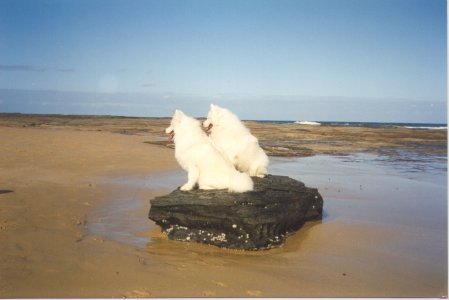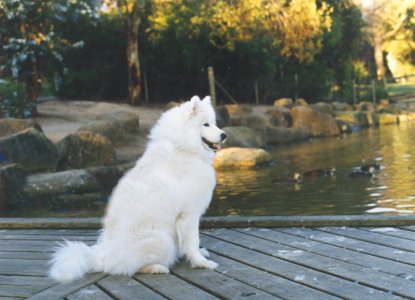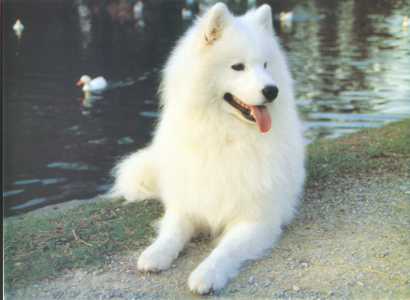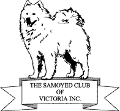About the Breed

The Samoyed is a fine example of an ancient working dog. His eye-arresting beauty and gentle, companionable nature, coupled with unusual intelligence, demand the love and loyalty of his owner, which he will return a hundred-fold.
His magnificent white coat has two layers, a dense, woolly undercoat, which is typically shed out once a year, and a silver-tipped harsh outer coat of long, straight guard hairs. Grooming this lovely coat can be a pleasure, or a chore, for both dog and owner.
Hardy, vibrant and even tempered, the Samoyed was originally used to hunt, herd reindeer, and haul sledges for the Samoyede people they served in north western Siberia. The Samoyede tribesmen were peaceful nomads, who manifested extraordinary love for their beautiful dogs, treating them as members of the family. Thus their dogs developed a love and understanding of humankind and an unfailing sense of trust and loyalty which is retained in the breed to this day. They remain the delightful playmates and faithful protectors of children.

Samoyeds were brought out of Siberia at the end of the 19th century and the early part of the 20th century to pull sledges on Arctic and Antarctic expeditions. These valiant dogs endured terrible hardships serving man in his quest for the poles. Only a few returned. Clearly, no toy or miniature version of the Samoyed breed could have performed those tasks.
Only one breed; the powerful, gentle, magnificent Samoyed - a true working dog. Despite his Arctic heritage, the Samoyed has adapted well to warmer climates. He can sleep outside, although he prefers to sleep inside, and needs to spend a significant part of each day being a beloved part of the family, in the centre of everything you do. We Sam fanciers find this zealous participation in the whole of our lives to be their greatest asset.
Samoyeds are active, inquisitive, quick witted and mischievous. They remain playful through to old age. With a twinkle in their dark, intelligent eyes and their ever present Samoyed smile, they are truly dogs with Christmas in their hearts the whole year long.
Samoyed Standard

GENERAL APPEARANCE - The Samoyed being essentially a working dog should be strong and active and graceful And as his work lies in cold climates his coat should be heavy and weather-resisting.
He should not be too long in back, as a weak back would make him practically useless for his legitimate work; but at the same time a cobby body, such as a Chow's would also place him at a great disadvantage as a draught dog.
Breeders should aim for the happy medium, viz. a body not long, but muscular, allowing liberty, with a deep chest and well sprung ribs, strong neck proudly arched, straight front and exceptionally strong loins. Both dogs and bitches should give the appearance of being capable of great endurance but should be free from coarseness.
A full grown dog should stand about 53.5 cm (21 ins.) at the shoulder. On account of the depth of chest required the legs should be moderately long, a very short-legged dog is to be deprecated. Hindquarters should be particularly well developed, stifles well angulated, and any suggestion of unsound stifles or cow-hocks severely penalized .
CHARACTERISTICS - The Samoyed is intelligent, alert, full of action but above all displaying affection towards all mankind.
TEMPERAMENT - (See under Characteristics.)
HEAD AND SKULL - Head powerful and wedge-shaped with a broad, flat skull, muzzle of medium length, a tapering foreface not too sharply defined. Lips black. Hair short and smooth before the ears. Nose black for preference, but may be brown or flesh-coloured. Strong jaws.
EYES - Almond shaped, medium to dark brown in colour, set well apart with alert and intelligent expression. Eye rims should be black and unbroken.
EARS - Thick, not too long and slightly rounded at the tips, set well apart and well covered inside with hair. The ears should be fully erect in the grown dog.
MOUTH - Upper teeth should just overlap the under teeth in a scissor bite.
NECK - Proudly arched.
FOREQUARTERS - Legs straight and muscular with good bone.
BODY - Back medium in length, broad and very muscular. Chest broad and deep ribs well sprung, giving plenty of heart and lung room.
HINDQUARTERS - Very muscular, stifles well angulated; cow hocks or straight stifles very objectionable.
FEET - Long, flattish and slightly spread out. Soles well cushioned with hair.
TAIL - Long and profuse, carried over the back when alert; sometimes dropped when at rest.
GAIT/MOVEMENT - Should move freely with a strong agile drive showing power and elegance.
COAT - The body should be well covered with a thick, close, soft and short undercoat, with harsh hair growing through it, forming the outer coat, which should stand straight away from the body and be free from curl.
COLOUR - Pure white; white and biscuit; cream.
SIZE - Dogs 51-56 cm (20-22 ins) at the shoulder.
Bitches: 46-51 cm (18-20 ins) at the shoulder.
Weight in proportion to size.
FAULTS:
- Severe unprovoked aggressiveness.
- Long foreface.
- Blue or very light eyes.
- Big ears with very little feathering.
- Drop ears; narrow width between ears.
- A bull neck. A long body.
- Slack tail carriage; it should be carried well over the back, though it may drop when the dog is at rest.
- Round, cat-like feet.
- A soft coat; a wavy coat; absence of undercoat.
- Absence of Feathering.
- Black or black spots.
- Any sign of unsound movement.
NOTE - Male animals should have two apparently normal testicles fully descended into the scrotum.






